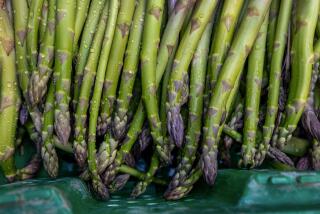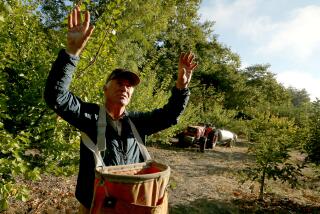Celebrating Celery : An abundance of the vegetable has brought prices down. There are 11,200 acres devoted to its cultivation in Ventura County.
Itâs time to stalk up. Ventura Countyâs abundant celery harvest has recently kicked into high gear. Low prices and high quality are sure to please enthusiasts of this low-calorie vegetable staple.
And while celery remains Ventura Countyâs third-largest cash crop--totaling $84.4 million for 1990--it is also one of the costliest to grow, according to Jeff Foster, a salesman with Boskovich Farms in Oxnard, a major producer of a wide variety of seasonal fruits and vegetables. (Lemons and strawberries rank No. 1 and No. 2, respectively, as the top moneymakers.)
Farmers use two planting methods, Foster said. Celery seeds are sown directly into manicured beds, or nursery-raised seedlings are transplanted to the fields.
âItâs much more common to transplant,â he said, âbut it is by far more expensive than direct seeding.â
Not only are seedlings expensive, but celery also requires a lot of water because it remains in the ground longer than most vegetables, Foster said.
The costlier transplanted alternative can prove more lucrative in the end.
âIt ensures a more even crop growth and better yield per acre,â Foster said. âAnytime you grow direct from seed youâll have problems, such as water erosion.â And birds can enter the field to feast on the seed.
On average, farmers can expect to incur costs of about $3,000 per acre to grow the crispy, stalked vegetable.
âAnd thatâs just to grow the stuff,â Foster said. âItâs even more once you factor in packing and carton costs.â Lettuce costs about half as much per acre to grow.
Ventura Countyâs celery harvest--the largest in California and second only to Floridaâs--commences in mid-November. The vegetable is planted in 90- to 120-day cycles.
âThe harvest continues through July 15,â Foster said, a date that is strictly enforced by the state.
âAfter that, the fields must be fumigated,â he said. The intention is to cleanse the soil of a pesky fungus, the mosaic, which can prove detrimental to the plant if its growth cycle is not broken.
âItâs different for other areas--such as the Salinas area--they have to stop Dec. 31,â he said.
Although you might not notice taste-wise, a variety of celery strains are grown for differing climatic conditions.
âWe plant different types for different periods of the year,â Foster said. âSome are resistant to cold weather, whereas in the spring the seedlings will grow a little quicker and are resistant to the warmer days we might have.â
According to the California Agricultural Statistics Service, 11,200 acres are set aside in Ventura County for celery. A lot is grown because a lot is consumed.
âCelery is one of the more versatile vegetables,â Foster commented. âThis time of year a lot of it is purchased to be used in stuffing.â
Commonly sliced up for salads and relish trays, celery has many more useful culinary applications.
âWe mostly chop it up and use it in soup stocks, like chicken or beef,â said Marty Gay, co-owner and chef of MKâs Restaurant in Ojai. Celery, he said, is a great flavor enhancer because it contains a lot of sodium.
âI like celery but itâs incredibly boring,â he commented.
If youâre watching your caloric intake, celery might be a noshing favorite. âItâs about one of the only vegetables with so-called ânegative calories.â It takes more calories to digest celery than you ingest by eating it,â Gay said.
To ensure freshness after purchasing, Foster suggests placing celery in a plastic bag. âKeep it open, allowing the celery to breathe, and place it in the (refrigerator) crisper,â he said. âIf youâve had the celery for more than two or three days, shoot it with some cold water before you serve it and that will crisp it up a little.â
Consumer prices, which have been good, should remain quite reasonable, Foster said.
âPrices have been pretty low due to an increase in acreageâ and a sluggish economy, he said.
âNormally farming is insulated from the economy, but this recession is really affecting the sale of fruits and vegetables,â he said, adding that low prices should continue possibly until May.
âItâs bleak for the growers,â he said, âbut good for consumers.â
More to Read
Eat your way across L.A.
Get our weekly Tasting Notes newsletter for reviews, news and more.
You may occasionally receive promotional content from the Los Angeles Times.










